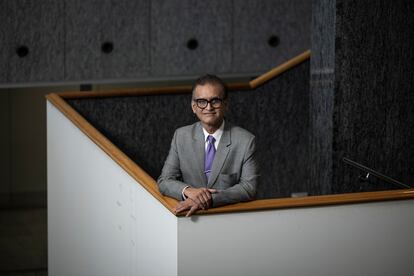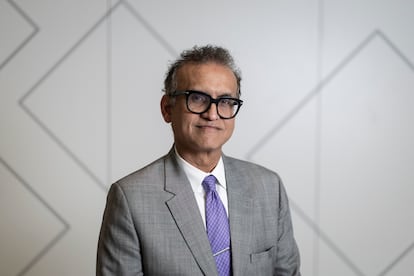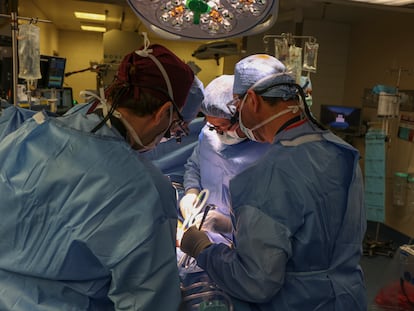The architect of pig heart transplants: ‘The patient can decide whether they want an organ from a sick person or a healthy pig’
Muhammad Mohiuddin is a pioneer in cardiac xenotransplantation with porcine hearts: his team has already carried out successful transplants for two patients, though they died within a few weeks of surgery

A flying pig with a superhero cape on its back was projected for a few seconds on the giant screen in the auditorium of the Hospital Sant Pau in Barcelona. “They used to say that the xenotransplants would work when pig flew. Well, the pigs are flying,” said transplant surgeon Muhammad Mohiuddin (Hyderabad, India, 59 years old) at the conclusion of the scientific conference he led a few weeks ago. The doctor, who is the director of the cardiac xenotransplantation program at the University of Maryland, is a pioneer in transplanting pig hearts into humans. His team successfully carried out the world’s first in 2022 with patient David Bennett, and repeated the feat in 2023 with Lawrence Faucette. The doctors were able to transplant the animal organ in both cases and prolong the men’s lives, but for only a short time: both died a few weeks after receiving their grafts. Nonetheless, this story is that of the first living proof of what can be done. The technique proved feasible: a pig heart could beat in a human being’s chest.
Xenotransplant — organ or tissue transplant from animals to people — has emerged as an alternative in the face of a global lack of donors. “In the United States, 150,000 people are waiting for a transplant. Every 80 minutes, someone dies for want of an organ,” explained Mohiuddin, who visited Barcelona on May 9 to participate in events commemorating the 40th anniversary of Spain’s first heart transplant, which took place in Sant Pau in 1984. In Spain, one of the world’s leading countries when it comes to donations and transplants, 6,000 procedures were carried out in 2023 and as of December 31, 4,794 people were on the waiting list to receive an organ.
Mohiuddin has spent more than three decades involved in the study and development of xenotransplantation. He says that doctors learned from their experiences with the two patients, and underlines the fact that both were very ill, with nearly no chance of long-term survival. During a quick interview with EL PAÍS between talks, the surgeon said they’d push on, despite the technical complexity of the procedure and the ethical considerations that it conjures: from the threat of rejection — the animal organs that are used are genetically modified to reduce the risk of an unfavorable rejection by the transplant recipient’s immune system — to the possible risk of introducing animal virus in the humans that become active or embedded in their DNA, as well as the ongoing debate regarding animal rights.
Question. Is your team ready for its third heart xenotransplantation?
Answer. Yes, we are trying to find a good patient. We are trying figure out how we can improve, based on our learning from the two transplants we have done.
Q. What is the objective of xenotransplantation? An infinite supply of organs?
A. Yes. Once this is successful and you have consistent long-term survival, then you can offer this to many people who cannot get [a transplant of human] hearts. Everyone who needs a heart or any other organ — because this is not just hearts, you can use other organs from the pigs also — will be able to get an organ and not wait long term.
Q. Why did you choose pig organs?
A. The pig is not very close to humans, like baboons or chimpanzee monkeys. But it takes a long time before a monkey gets to a size of human. Also, there are diseases like HIV (AIDS), that can be transmitted from the monkey organs or their cells. That’s why we don’t use them. In pigs, now, with our ability to modify the gene, we can quickly modify the gene [to reduce the risk of transplantees’ bodies rejecting the organ]. And these pigs grow very fast. Within one year, they grow to a size that would be suitable for adult humans.
Q. At what stage of maturity is this technique?
A. All the previous work was done on animals, and now we have started on humans. We have to overcome those differences and try to keep the heart [functioning] for a long period of time. Also, the patients that we are using are very sick. If we get a patient who is not that sick, the outcome will be better.
Q. And what is the final objective? Save time with the animal organs until we have a human organ to transplanted, or to live forever with these animal organs?
A. When you say for a short period of time, that’s called a bridge for transplantation. With some of the organs, like the liver, you can bridge for a short period of time and then they get another organ. In hearts, if the heart is working fine, you can leave it until it fails. But if in the meantime, you find another human heart, you can exchange it. But the transplant is very difficult, and every time you take out that heart and put it back in, there are other complications. So it’s better, if the heart is good, to just leave it until it fails and then put in another pig heart or human heart, if it is available.
Q. There may come a day when xenotransplantation exists normally alongside human organ transplants. How would you decide that this pig heart goes to this patient, and this other human organ goes to another person?
A. There’s already a committee that decides who gets a human organ. The two patients we did, they were denied, they could not get a human organ. They either got the pig organ or they died. So that’s why, when this process becomes common, maybe the patient can decide if they want a human organ from an older person or a diseased person, or a fresh organ from a healthy pig. It will be presented to the patient and they can decide.
Q. You transplanted pig hearts into two patients, David Bennett and Lawrence Faucette. Both died. How is that interpreted in scientific terms?
A. The meaning is that we are learning what’s going on from these patients. All the previous experiments were done on healthy baboons, they didn’t have any disease, we did the transplants and learned from them. But these patients, they were very, very sick. So, we are now learning how to change our drug regimen, what additional changes we need to make and what not to use in these patients to keep the heart alive for longer periods of time. What we learned from first patient, we didn’t do and we improved with the second patient. But it will be a stepwise process.

Q. What specifically went wrong in those two cases?
A. We think that the antibodies that are present in our human system can attack and kill the organ. That’s what we think happened.
Q. Are you able to control rejection very well? Or how can that field be improved?
A. From human to human, the same thing happens. Initially when heart transplants were done [between humans], the heart didn’t used to survive for long. But then new drugs came out that suppressed that rejection very well. So, we think that we will be able to suppress this rejection, because there are a lot of drugs that are working very well in animals, but they are not approved for humans. One day, these drugs will be approved for humans also, and be able to suppress rejection very well.
Q. One of the risks or controversial topics around this technique is the introduction of new viruses into the human population. Bennet’s heart transplant involved a porcine virus. Is there a high risk of this happening?
A. There is no evidence that these viruses can infect humans. They can infect pigs if they get activated. There is no evidence that they can infect humans so far. Our regulatory agencies want us to monitor the patient as long as they live and keep checking on not only them, but their family members and anybody who they come in contact with, to make sure that this virus doesn’t get activated and infect humans. Not much work has been done in humans, but in the slaughterhouse where they sacrifice pigs for meat and all that, [workers] get cuts and bruises, they come into contact with blood... There have been studies that showed that they never have gotten any virus from a pig.
Q. There is another controversy around the issue of animal rights. There are people who report or criticize that these animals are used for medical purposes, as a simple tool at our service. What do you think about that?
A. Yes, there is a concern. Nobody wants to kill extra animals. But all research so far, all the drugs that we use, they all have been experimented on animal models, either rats, mice or on large animal models. Pigs have been used for food in many countries, it is the most used meat throughout the world. Just in the United States, 90,000 pigs are killed every day for food. We are talking about less than a thousand pigs, and from each pig, you can save about seven lives, with different organs.
Q. What are the big knowledge gaps in this field?
A. Although we knew that these patients may not live for long, we wanted them to live for at least six months, because our baboons live for nine months or more. We wanted to find out the difference between what we learned for animal models versus what we learned from human models and try to overcome that. Antibodies are one of the things that are not well controlled well with sick patients because we cannot give enough of the drug [to avoid rejections], because the drug creates its own problems as well.
Q. The pig heart that went to Bennet came from a private company, Revivicor. If private companies enter into xenotransplantation, could altruism when it comes to donations and transplants be in danger?
A. As with any other medication, these pig hearts will be sold to save lives. And it’s thanks to these companies that we can do it, because the research is so expensive that not even the U.S. government has the luxury of giving us enough money to do this. Although these companies do have their own motives, because they want to produce these pigs and then sell their organs, they are also interested in saving human lives. For that reason, I think that we should give the benefit of the doubt to these firms, because they are helping us to save these lives.
Q. Would you get a transplant of an animal organ, if you needed it? A pig heart, for example.
A. That’s the question people ask. But when you ask a healthy person if they would get a pig transplant, they might say no, but if I get to a stage at which I need a heart transplant, and I don’t have any other means to live, and if I feel like that animal can save my life, maybe yes.
Sign up for our weekly newsletter to get more English-language news coverage from EL PAÍS USA Edition
Tu suscripción se está usando en otro dispositivo
¿Quieres añadir otro usuario a tu suscripción?
Si continúas leyendo en este dispositivo, no se podrá leer en el otro.
FlechaTu suscripción se está usando en otro dispositivo y solo puedes acceder a EL PAÍS desde un dispositivo a la vez.
Si quieres compartir tu cuenta, cambia tu suscripción a la modalidad Premium, así podrás añadir otro usuario. Cada uno accederá con su propia cuenta de email, lo que os permitirá personalizar vuestra experiencia en EL PAÍS.
¿Tienes una suscripción de empresa? Accede aquí para contratar más cuentas.
En el caso de no saber quién está usando tu cuenta, te recomendamos cambiar tu contraseña aquí.
Si decides continuar compartiendo tu cuenta, este mensaje se mostrará en tu dispositivo y en el de la otra persona que está usando tu cuenta de forma indefinida, afectando a tu experiencia de lectura. Puedes consultar aquí los términos y condiciones de la suscripción digital.
More information
Archived In
Últimas noticias
Millennia-old Yuracaré language resists extinction through 900 speakers and a new dictionary
Susan Boyle prepares a comeback just as Timothée Chalamet sings her praises
Trump suspends green card visa lottery after shooting at Brown University
When things get out of hand at the lab: Hundreds of accidents expose the ‘catastrophic’ risk of dangerous pathogen leaks
Most viewed
- Christian Louboutin: ‘Young people don’t want to be like their parents. And if their parents wear sneakers, they’re going to look for something else’
- Cartels in Mexico take a leap forward with narco-drones: ‘It is criminal groups that are leading the innovation race’
- Liset Menéndez de la Prida, neuroscientist: ‘It’s not normal to constantly seek pleasure; it’s important to be bored, to be calm’
- ‘El Limones’ and the growing union disguise of Mexican organized crime
- The low-cost creative revolution: How technology is making art accessible to everyone











































